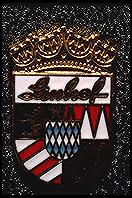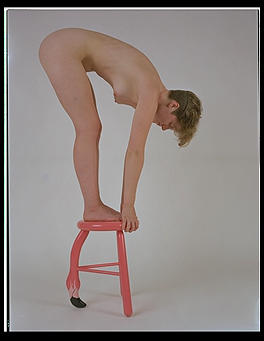
Linhof Master Technika
by Philip Greenspun; created 1998
Site Home : Photography : Linhof Master Technika

by Philip Greenspun; created 1998
Site Home : Photography : Linhof Master Technika
The Linhof Master Technika is a $5000 folding camera that takes 4x5" sheet film negatives. I own one because I keep thinking it will let me use a view camera in all kinds of new situations and places. If you want view camera movements and flexibility, the Technika has them and they are precise (unlike folding wooden cameras). If you want to pretend that you're a 1940s press photographer, e.g., Weegee, you can stick an anatomical grip on the side, a cammed lens on the front, a big flash on the other side, and blast away.
 The
camera does not let me shoot large format negatives casually. It is true that,
folded, it isn't too large: 8 x 7 x 4.5" (20 x 18 x 11cm). At 6 lbs. (2.6kg), it
is heavier than some field cameras, notably the Horseman FA, but only by a couple
of pounds. So why doesn't the Linhof Master Techika work as a beefy
point-and-shoot? Because there is simply too much other stuff you need to carry
around to expose 4x5 sheet film. The Linhof has a rangefinder that can be coupled
to various lenses and an accessory zooming viewfinder that fits into a shoe on
top. So in theory you can just aim, focus, and shoot. But in practice you won't
get the depth of field you need unless you stop down to f/22 in which case the
shutter speed will be slow enough that you'll want to use a tripod. At that
point, you really should flip open the back (with its nice folding focusing hood)
and check composition and focus with a loupe.
The
camera does not let me shoot large format negatives casually. It is true that,
folded, it isn't too large: 8 x 7 x 4.5" (20 x 18 x 11cm). At 6 lbs. (2.6kg), it
is heavier than some field cameras, notably the Horseman FA, but only by a couple
of pounds. So why doesn't the Linhof Master Techika work as a beefy
point-and-shoot? Because there is simply too much other stuff you need to carry
around to expose 4x5 sheet film. The Linhof has a rangefinder that can be coupled
to various lenses and an accessory zooming viewfinder that fits into a shoe on
top. So in theory you can just aim, focus, and shoot. But in practice you won't
get the depth of field you need unless you stop down to f/22 in which case the
shutter speed will be slow enough that you'll want to use a tripod. At that
point, you really should flip open the back (with its nice folding focusing hood)
and check composition and focus with a loupe.
I guess the old-time press photographers had Grafmatic backs and such that let them whip off exposures quickly. But the modern-day solution for the lazy tends to be Kodak Readyload or Fuji Quickload film. These have to be handled carefully and require a holder that, though not heavy, is bulky.
So you're heading out of the car with a tripod, the camera, a Quickload holder, a box of Fuji Quickload film (the Kodak stuff is really unreliable in my experience), a loupe, a cable release, and a light meter on your belt. That Canon EOS-5 is starting to look pretty good. The Yashica T4 point-and-shoot camera is looking even better.
The bottom line is that when I take a trip with my cameras, I end up covering most subjects with my Canon EOS system, a few with my Fuji 617 camera, and hardly any with the Linhof.
OK, it might be a pain to set up, but once you get the thing on a tripod, it is ultimately flexible, no? No. It is pretty fast to level the camera on a tripod and then shift the lens up to take a perspective-correct image a building. But if you want to shift the lens down, you have to drop the front tray and then tilt the lens back to bring it parallel again with the rear standard (i.e., the film). You have to guess at whether the standards are in fact parallel. Remember that if they aren't, you will get subtle unsharpness and you might as well have used a wooden view camera or could even have gotten better results with a 35mm SLR and PC lens.
On about 1/10th of the pictures that you take, you'll long for the flexibility of a traditional studio monorail, e.g., Sinar X. What I especially miss from my old Sinar F2 are all the little calculator wheels that tell you (1) what aperture you need to get enough depth of field, (2) at what angle you need to tilt the lens and/or film plane to bring a tabletop into focus via the Scheimpflug Rule. (see B&H Photo's large format introduction if you want some diagrams and background on view camera movements; or get hold of a copy of View Camera Technique)
One thing the Linhof does better than any other field camera I've seen is long extension. You can get something like 17" (435mm) of extension for macro photography and/or telephoto lenses.
In a world where it is too expensive to machine anything, where cameras look as though they were popped out of a mold, it is nice to own a product that is essentially unchanged since the Linhof Technika III was introduced in 1946. A Linhof has the same machined-by-German-elves feeling that you get from a Leica.
Note that apparently quality and actual reliability are different things. My Linhof has been babied and yet after only a handful of exposures, I experienced sticking with the shutter/cable release mechanism on the Linhof/Rodenstock 150mm lens that was included with the camera.

(John Belushi's grave on Martha's Vineyard, about which you can find out more in my Cape Cod exhibit)
I recommend the IV, the V, the Master, or the Master 2000 (takes super wide-angle lenses without additional accessories). It is tough to get certain modern lenses back into a III and also the current accessories won't fit. Each newer model adds some movements and features that are useful. Buy whichever one fits your budget.
Oh yes, prepare for pain if you want to use lenses wider than 75mm on a Technika. Rather than go into the gory details of using super wide-angle lenses on this series of cameras, I will recommend that you instead get a Master 2000 (about $6000; accepts lenses down to 45mm) or a Toyo 45AII camera (accepts lenses to 45mm with recessed boards; you don't have to monkey with the bellows; also has an "easy-load" bail at the rear for inserting film holders without disturbing the camera position).
For my style of photography, what would work better is a nice fitted case containing a Sinar X and all the ancillary stuff. Load it into the new minivan and use the Toyota to get within 100 meters of the subject. If it is more than 100 meters from the car, it isn't photogenic.
Some miscellaneous pictures...